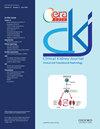Associations between acute kidney injury and bone fractures: a retrospective cohort study
IF 3.9
2区 医学
Q1 UROLOGY & NEPHROLOGY
引用次数: 0
Abstract
Background Acute kidney injury (AKI) is common. An AKI episode may disrupt the normal mineral bone balance maintained by normal kidney function, thereby modifying the risk of developing bone fractures. However, it remains unclear if an AKI episode is associated with the risk of bone fractures. Methods Using retrospective cohort study from an Australian Local Health District, we examined the association between an AKI episode and bone fractures using patient data between 2008 and 2017. Time-varying Cox proportional hazards and propensity-matched analysis were used to examine the association. Sensitivity analyses were undertaken to capture the impact of confirmed AKI status and AKI severity. Results Of 123 426 included patients, 14 549 (12%) had an AKI episode and 12 505 (10%) had a bone fracture. In the unadjusted analysis, AKI was associated with bone fractures [hazard ratio (HR) 1.99, 95% confidence interval (CI) 1.88- 2.11]. This association persisted in the adjusted analysis (HR 1.50, 95%CI 1.41- 1.59) and propensity matched dataset (HR 1.71, 95%CI 1.59- 1.83). The sensitivity analysis yielded similar results with the AKI patients having a higher risk of fractures compared to no AKI patients in the adjusted analysis (HR 1.34, 95%CI 1.25- 1.43) and in the propensity matched dataset (HR 1.44, 95%CI 1.33- 1.55). Similar results were seen in the subsidiary sensitivity analysis excluding patients without baseline creatinine. We did not find an increased risk of bone fractures with increasing AKI severity (P = 0.7). Interaction tests demonstrated a significant association between sex and age category with AKI status and fractures, but not CKD stage or osteoporosis. Conclusions AKI is associated with a greater risk of bone fractures. This could have implications for managing and screening for bone disease in patients post AKI episode. This association should be examined in other cohorts and populations for verification.急性肾损伤与骨折之间的关系:一项回顾性队列研究
背景 急性肾损伤(AKI)很常见。急性肾损伤可能会破坏由正常肾功能维持的正常矿物质骨平衡,从而改变发生骨折的风险。然而,目前仍不清楚急性肾损伤是否与骨折风险有关。方法 我们利用澳大利亚一个地方卫生区的回顾性队列研究,使用 2008 年至 2017 年期间的患者数据,研究了 AKI 事件与骨折之间的关联。我们采用了时变考克斯比例危害分析和倾向匹配分析来研究两者之间的关系。进行了敏感性分析,以了解确诊的 AKI 状态和 AKI 严重程度的影响。结果 在纳入的 123 426 例患者中,14 549 例(12%)发生过 AKI,12 505 例(10%)发生过骨折。在未经调整的分析中,AKI 与骨折有关[危险比 (HR) 1.99,95% 置信区间 (CI) 1.88-2.11]。在调整分析(HR 1.50,95% 置信区间 1.41-1.59)和倾向匹配数据集(HR 1.71,95% 置信区间 1.59-1.83)中,这种关联依然存在。敏感性分析得出了类似的结果,在调整分析(HR 1.34,95%CI 1.25-1.43)和倾向匹配数据集(HR 1.44,95%CI 1.33-1.55)中,与无 AKI 患者相比,AKI 患者的骨折风险更高。在排除无基线肌酐的患者的辅助敏感性分析中也发现了类似的结果。我们没有发现骨折风险随着 AKI 严重程度的增加而增加(P = 0.7)。交互测试表明,性别和年龄类别与 AKI 状态和骨折有显著关联,但与 CKD 分期或骨质疏松症无关。结论 AKI 与更高的骨折风险相关。这可能会对管理和筛查 AKI 后患者的骨病产生影响。这种关联应在其他队列和人群中进行研究以验证。
本文章由计算机程序翻译,如有差异,请以英文原文为准。
求助全文
约1分钟内获得全文
求助全文
来源期刊

Clinical Kidney Journal
Medicine-Transplantation
CiteScore
6.70
自引率
10.90%
发文量
242
审稿时长
8 weeks
期刊介绍:
About the Journal
Clinical Kidney Journal: Clinical and Translational Nephrology (ckj), an official journal of the ERA-EDTA (European Renal Association-European Dialysis and Transplant Association), is a fully open access, online only journal publishing bimonthly. The journal is an essential educational and training resource integrating clinical, translational and educational research into clinical practice. ckj aims to contribute to a translational research culture among nephrologists and kidney pathologists that helps close the gap between basic researchers and practicing clinicians and promote sorely needed innovation in the Nephrology field. All research articles in this journal have undergone peer review.
 求助内容:
求助内容: 应助结果提醒方式:
应助结果提醒方式:


